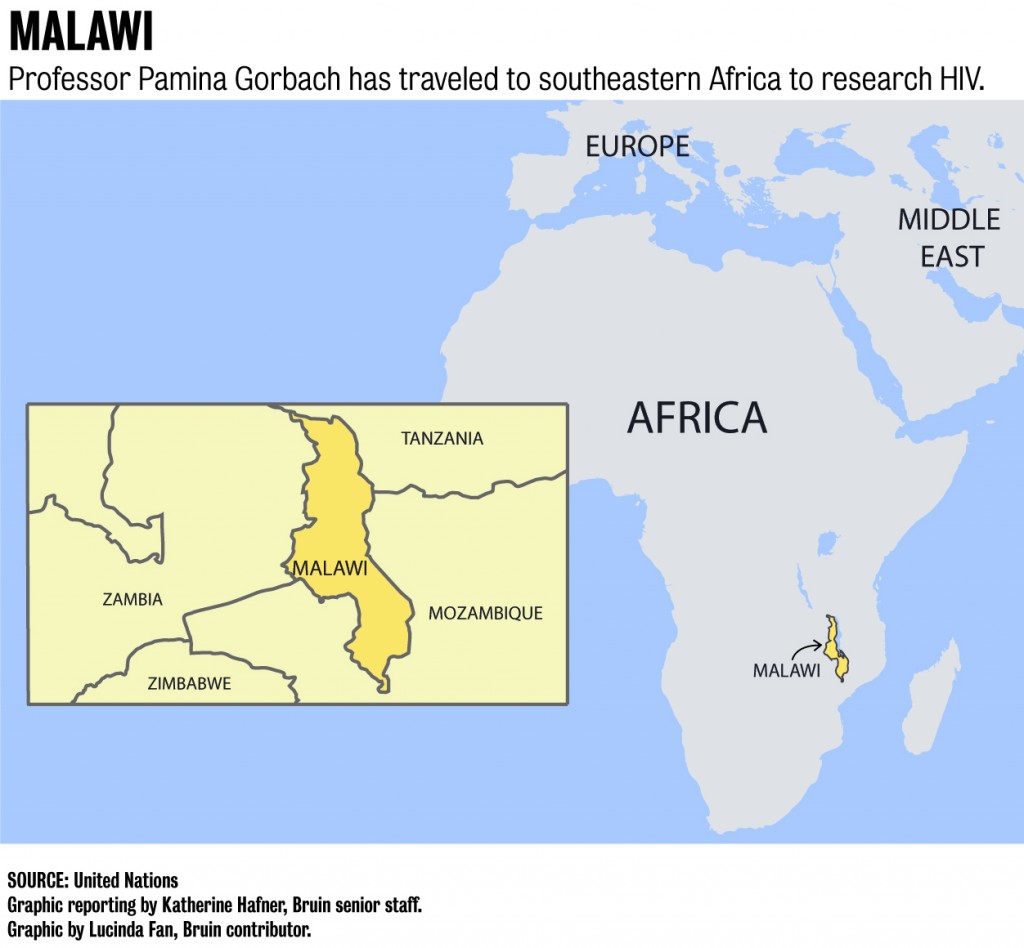Pamina Gorbach is often faced with the challenge of asking strangers about their sex life.
The associate professor in the UCLA department of epidemiology in the Fielding School of Public Health uses the conversations to understand sexually transmitted diseases and human immunodeficiency virus, commonly known as HIV.
“In the general world, we always joke I don’t have the greatest cocktail conversation work,” Gorbach said.
Gorbach, who specializes in behavioral epidemiology, has travelled to nine countries to research the ways in which human actions influence bodily infection and to improve treatment for infections.
She draws from these experiences in her lectures for Epidemiology 100, a class that explores factors that influence health in populations.
Gorbach’s interest in sexually transmitted infections began when she was conducting research for her doctorate in Vietnam.
“When I started working in women’s reproductive health it was right at the time the HIV epidemic started taking off,” Gorbach said.
Her interest in sexually transmitted infections eventually evolved into HIV research, which later led to her extensive studies on HIV transmission.
Gorbach’s inclination toward behavioral epidemiology research goes beyond her doctoral thesis.
Both of her parents worked in fields that partake in elements of behavioral epidemiology – her father in infectious disease research and her mother in public health.
“So I’m sort of a blend,” she said.
Sexual health-related questions, as well as questions about certain sexual behaviors, are sensitive subjects to address in face-to-face interviews because the people interviewed feel obligated to tell the researcher what they would like to hear, said Marjan Javanbakht, an associate professor in the department of epidemiology in the Fielding School of Public Health who works with Gorbach.
“They want to say the right things, so they may not be so forthcoming with what they tell you,” Javanbakht said. “So we use technology a lot to help us, to sort of remove that sort of person out of the interview.”
Gorbach and Javanbakht have collaborated as colleagues in the epidemiology and public health departments, studying the spread of sexually transmitted infections, including HIV.
One important aspect of their research is developing techniques with which to debrief the people they question, because the nature of the information disclosed is often sensitive for the subject, Gorbach said.
This reporting issue is the reason why alternative devices, such as a hand-held computer, were applied to the field – to help increase the accuracy of these studies, Gorbach said.
While in Malawi in 2008, Gorbach used a touch-screen device to interview the native people in a study measuring the use of a microbicide gel developed to prevent the tranmission of HIV.
Instead of talking to a person, Gorbach had people answer questions on a hand-held device to make the person feel more comfortable answering sensitive questions.
Though this alternative method allowed the researchers to gain insight into more of the sexual behaviors of the subjects, Gorbach and her colleagues found that the reported use of the microbicide gel did not improve among the people who were tested.
The reports gave researchers data on sexual behaviors of participants that they may not have been able to find out in a face-to-face interview.
The additional information helped highlight specific behaviors that are related to HIV transmission.
Gorbach is utilizing the same technology she used in Malawi in studies she is conducting in the United States.
One study, which is set to start this summer, will use computer-generated avatars to interview test subjects in a more engaging environment.
The study is an extension of the Adolescent Trials Network, one of the many networks for which Gorbach serves as an investigator.
 [media-credit name=”Lucinda Fan” align=”alignnone” width=”620″]
[media-credit name=”Lucinda Fan” align=”alignnone” width=”620″]
Kristin Meyer, a research analyst in the behavioral epidemiology research group, has been working with Gorbach on clinical trials and other studies since September.
She said she thinks Gorbach’s technology is a different approach to the field of behavioral epidemiology, which is why she enjoys working with the research team.
“I love the idea of harnessing modern technology … to reach select populations with health messages and information,” Meyer said. “(Gorbach) is an extraordinary collaborator and scholar, who is exceedingly supportive and lots of fun to work with.”
In addition to teaching and researching, Gorbach fills her days caring for her 4-year-old twins, Pi and Persie. She said the twins’ teachers have in the past asked her to visit the class and talk about her work.
“I don’t know how well that would come off with my kids,” Gorbach said, laughing. “I don’t really have good, classroom-friendly work topics.”
